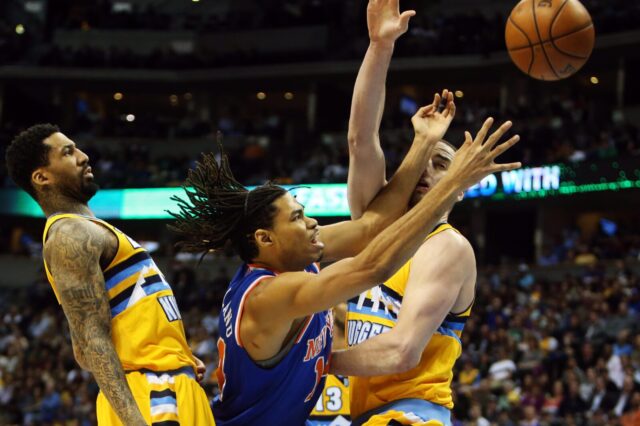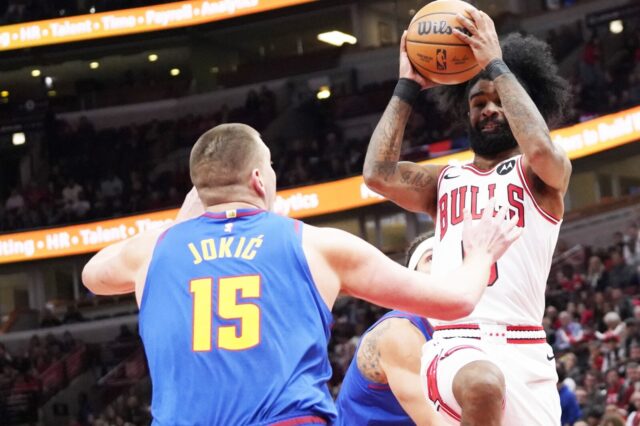It has only been two games since the All-Star break wrapped up, but the ramifications of a fully healthy rotation have already had an impact on Michael Porter Jr. and the Denver Nuggets.
During the month of January, Porter averaged 21.4 minutes per game over 15 games of excellent play from the rookie. The 321 total minutes were more than he had played in October, November, and December combined. He scored 25 points on 11-of-12 from the field on January 2nd against the Indiana Pacers. He dropped 20 points, 14 rebounds, and 4 assist against the Minnesota Timberwolves on January 20th. He was in the middle of an excellent performance against Giannis Antetokounmpo, Khris Middleton, and the Milwaukee Bucks on January 31st when he rolled his ankle early in the fourth quarter.
Porter sat for six games. He sat out All-Star Break festivities. It wasn’t until February 21st, three full weeks of actual time, that Porter made his return against the Oklahoma City Thunder. It didn’t go well, as he played just eight minutes and actively hurt the Nuggets while he was out there. It was a similar story against the Timberwolves on Sunday, as Porter logged 10 minutes, including garbage time, against a T’Wolves squad without Karl-Anthony Towns or D’Angelo Russell. In both games, Porter appeared uncomfortable with his role, less apt to sky for a rebound, and tentative with the ball in his hands in most scoring situations. The Nuggets can’t have that from him if he wants real minutes. His defense at small forward isn’t doing him any favors, so the offense has to be good.
After showcasing his talents in January, it became clear that the Nuggets had to move forward with the rookie playing a role in a playoff rotation. The Nuggets front office brass felt comfortable enough with his place on the team that they executed the Malik Beasley, Juancho Hernangomez, and Jarred Vanderbilt trade in the first place. With Torrey Craig as the only other viable wing with size off the bench, the Nuggets tethered themselves to playing Porter when the time comes. In the playoffs, when rotations shorten up and skilled size begins to really matter, players like Porter can have a major impact on swinging a playoff series.
The version of Porter over the last two games is not an impactful playoff piece. He’s not comfortable. He’s not scoring. He’s not rebounding.
So, how can the Nuggets get Michael Porter Jr. going again?
Continue playing Michael Porter Jr. and Nikola Jokic together
The back door cuts are great evidence for growing chemistry between two of Denver’s foundational pieces. During the month of January, it felt like Jokic and Porter were connecting on at least one cut a game generating what amounted to free points. Porter’s size and athleticism make for an easy target for Jokic when Porter gets to the rim.
It’s no secret that playing with Nikola Jokic can help inflate a player’s numbers, and Porter is no exception. Jokic helps guys do what they do best, and Porter is an elite cutter. Here are Porter’s splits with Nikola Jokic ON and OFF the floor:
This content is no longer available.
The production isn’t anything special with Jokic on the floor. Porter usually isn’t the focus of things while Jokic is out there; however, that’s the joy of playing with Jokic. He makes the right decisions, gets the ball to the right place, and Porter plays more efficiently because of it, making better decisions with the basketball and hitting three-pointers at an excellent clip. Lineups with Jokic on Porter on the floor at the same time have produced a 114.6 Offensive Rating and are a net positive.
But more than anything, Porter playing with Jokic is great preparation for a playoff run. Jokic averaged nearly 40 minutes per game in the 14 playoff games Denver played last year. Remove the four overtimes from the Portland Game 3 thriller, and he still averaged over 38 minutes per contest. Jokic will be on the floor in almost every critical circumstance, and Porter’s size/athleticism/shooting combination could make things easier for Jokic on the offensive end. Creating an extra assist for Porter means one less bruising post touch per game during what Denver hopes to be a deep postseason run. The best way to keep Jokic fresh is to give him other options, and Porter represents that.
Put Porter in shooting situations
The numbers don’t lie. Porter is shooting 42.2% from behind the three-point line on the year. He has plenty of shooting talent, even in difficult shooting situations with defenders closing out on him.
In the same game on separate occasions, Porter received a pass in the corner from Jokic and converted a contested corner three. This is where being 6-foot-10 with a high release point on his shot helps the rookie make things easy on himself. No hesitation. Catch-and-shoot.
Beyond the simple three-point percentage, Porter is an elite catch-and-shoot guy. Among the 234 players to attempt at least 65 C&S threes (Porter’s total attempts), Porter ranks 49th in three-point percentage at 41.5%, right in between Danilo Gallinari, Kelly Olynyk, and Landry Shamet.
(On an aside, Paul Millsap ranks sixth in the above group, shooting an absurd 47.0% on C&S threes himself.)
In terms of wing shooters to play off of Jokic and Jamal Murray as creators, Porter is probably Denver’s best option. He has the height to fire off almost any jump shot and the accuracy to match. Teams have to respect his jump shot, and in doing so, the paint opens up for many of the actions Denver likes to run for their primary creators.
On the season, the Nuggets have a win-loss record of 21-4 when they hit 35+% of their three-point attempts. That means they are 18-14 when they don’t. Having options on a variety of elite three-point shooters in the playoffs will be key to advancing in the early rounds. The Nuggets are at their best when the shooting doesn’t dry up. Michael Porter Jr. could contribute some positive shooting in the right circumstance.
Let him do stuff and grow from it
The Nuggets learned last season that the playoffs can have wild swings in pace and style, but they always fall back to several slow possessions in key moments where teams grind out every scoring opportunity they possibly can. For the Nuggets, they are well-equipped for these situations if the Jokic-Murray two-man can is operating at peak efficiency.
But in situations where the Jokic-Murray game isn’t working, or if one or both of those guys is on the bench, the Nuggets have to be comfortable with other options offensively. Will Barton has been awesome. Monte Morris has established himself as an effective creator, and he could very well alter entire games with his scoring and playmaking. Paul Millsap and Jerami Grant have been effective in pick and pop situations as a stretch five. Still, when plays break down and the Nuggets simply need a player who they can pass the ball to and expect some points, they are lacking in consistent options.
Porter has been effective in isolations in a small sample size, scoring 18 points on 17 possessions for a rate of 1.06 points per possession, which ranks in the 84th percentile league wide. That is the highest average for the Nuggets in isolation situations. Other players that average a similar PPP: Luka Doncic (1.07), Kyrie Irving (1.06), and Kawhi Leonard (1.05). That’s good company.
Sometimes, the best vote of confidence in a player is to just give them an opportunity. Putting the ball in his hands has generally yielded good things this year. He has even made some nice passes when defenses overcommit to him, and it’s good to see the scoring vision doesn’t block out other passing options entirely.
Go small with Porter at power forward and give those lineups space
Some of Porter’s best minutes have come at power forward this season. He spent most of January primarily at power forward while Paul Millsap and Mason Plumlee were sidelined with injuries. While the Michael Porter – Jerami Grant – Nikola Jokic front line appears to be Denver’s future, the Nuggets have had some success with Porter as the power forward. The Nuggets have been mostly effective in these situations, especially using bench lineups.
This content is no longer available.
Compare this to the data with Porter at small forward, which has one visible difference:
This content is no longer available.
So far, the Porter-Grant-Plumlee lineup just hasn’t worked. There are subsections of it that involve two perimeter guard shooters that make it palatable, but for the most part, the Nuggets don’t have Stephen Curry and Klay Thompson in their back court to give the three front court players ample space to roam the paint. Despite that, the Porter-Grant-Jokic lineup started to figure some things out, and I’m curious to see how Porter operates next to Millsap-Jokic and Plumlee-Jokic going forward. Those combinations are intriguing.
But the predominant factor in the Porter discussion: he’s best with perimeter oriented players around him. The Porter-Grant-Jokic lineup works because Grant operates like a wing and Jokic directs traffic at the top of the key. The Porter-Grant-Plumlee lineup simply can’t operate in the same way.
Michael Malone said postgame on Sunday that he has to find a way to get Michael Porter Jr. going again and playing in a positive way. I don’t pretend to know how Malone will approach the issues at hand, but if I had to guess, it would involve some of the above scenarios. More minutes with Jokic generally cures all ailments, and getting Porter some easier shots should be at the top of the list of ways to get the 21-year-old forward going in the right direction. Sometimes, it’s as easy as seeing the ball go through the hoop a few times.
How much effort the Nuggets put into getting Porter right will go a long way in determining what they perceive his playoff role to be. If they expect him to be a major contributor like what many Nuggets fans are hoping for, then Malone will likely go out of his way to tailor some plays, rotations, and the overall direction of the team to how Porter can help the Nuggets win. If the Nuggets don’t expect Porter to play any more than the minutes of a standard 9th man in a playoff series, then I don’t expect them to bend over backwards trying to get the rookie back on track. The Nuggets have games to win. They can do most of those without catering to his needs.
What Denver can’t do is win a championship without him. His combination of physical traits and scoring gifts have made that abundantly clear. Very few teams can match up with him when he’s at his best, especially if he’s the third or fourth option on the floor. Can NBA teams hope to stop the Jokic-Murray two-man game, the secondary playmaking of Barton, the pick and pop play of Millsap and Grant, AND a fully optimized Porter? I’d imagine only the Milwaukee Bucks and MAYBE the Los Angeles Lakers could challenge that version of the Nuggets.
Will we see that version this season? I don’t know. What I do know: the Nuggets may have to go out of their way to put Porter in a better situation off the bench to make it happen.


